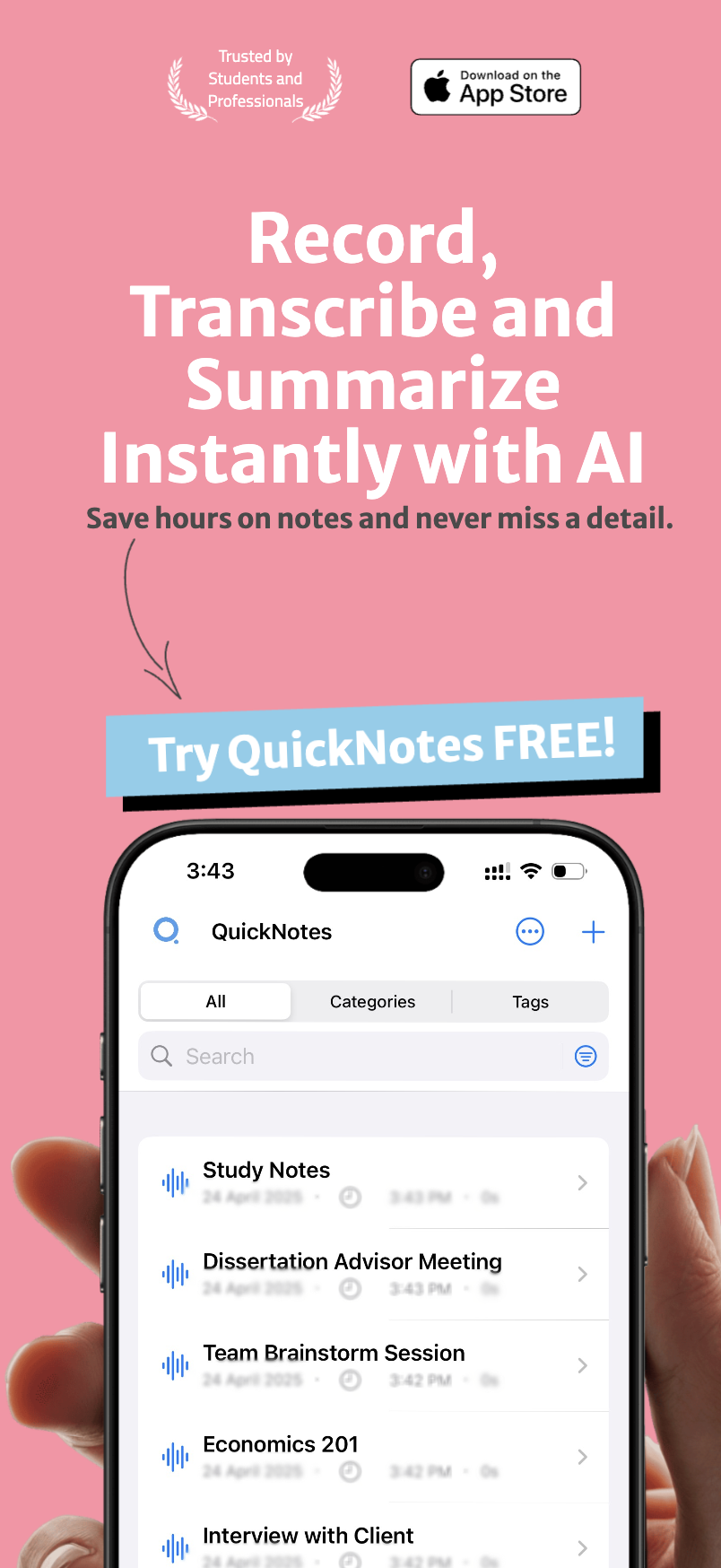When faced with complex subjects, lengthy textbooks, or interconnected topics, traditional linear note-taking often falls short. Information gets scattered across pages, connections between concepts remain hidden, and the big picture gets lost in a sea of details. If this sounds familiar, it might be time to add mind mapping to your study arsenal.
Table of Contents
- What Exactly Is a Mind Map?
- Why Mind Mapping Works: The Science
- Dual Coding Theory
- Chunking and Organization
- Pattern Recognition
- How to Create Effective Mind Maps for Studying
- Step 1: Start with the Central Concept
- Step 2: Add Primary Branches
- Step 3: Develop Secondary Branches
- Step 4: Use Colors Purposefully
- Step 5: Incorporate Images and Symbols
- Step 6: Connect Related Concepts
- Mind Mapping Applications for Different Study Scenarios
- Lecture Note-Taking
- Reading Comprehension
- Exam Preparation
- Project Planning
- Brainstorming
- Digital vs. Hand-Drawn Mind Maps
- Hand-Drawn Benefits
- Common Mind Mapping Challenges and Solutions
- Challenge: "My mind maps get messy and overcrowded."
- Challenge: "I'm not artistic enough to create effective mind maps."
- Challenge: "I'm not sure what to put at the center or how to organize branches."
- Integrating Mind Maps with Other Study Techniques
- Active Recall
- Spaced Repetition
- The Feynman Technique
- Conclusion: Mapping Your Way to Success
- You Might Also Like
Mind mapping is a visual study technique that mirrors how your brain naturally processes information—through connections, associations, and patterns. By transforming linear notes into colorful, radial diagrams, mind maps can revolutionize how you learn, understand, and remember information.
What Exactly Is a Mind Map?#
A mind map is a diagram that visually organizes information around a central concept. From this central point, related ideas branch outward in a radial pattern, creating a visual hierarchy and showing relationships between concepts.
The structure of a mind map typically includes:
- A central image or word representing the main topic
- Primary branches extending from the center, representing main categories or key themes
- Secondary branches extending from primary ones, adding detail and nuance
- Colors, images, and symbols to enhance memory and creative thinking
- Lines connecting related concepts across different branches
This structure mirrors how our brains actually store and retrieve information—not in neat, sequential lists, but in complex networks of associations.
Why Mind Mapping Works: The Science#
Mind mapping isn't just visually appealing—it's supported by cognitive science:
Dual Coding Theory#
Mind maps leverage both visual and verbal processing channels in your brain. Research shows that when information is processed through multiple channels, retention improves significantly. By combining words with spatial relationships, colors, and images, mind maps activate more neural networks than text alone.
Chunking and Organization#
Our working memory is limited, but we can expand its capacity by "chunking" information into meaningful groups. Mind maps naturally create these chunks through their hierarchical structure, allowing you to manage more information without cognitive overload.
Pattern Recognition#
Human brains are wired to recognize patterns and relationships. Mind maps make these patterns explicit, helping you see connections that might be obscured in linear notes.
"Mind Maps engage much more of the brain in the process of assimilating and connecting facts than conventional notes do." — Tony Buzan, Inventor of Modern Mind Mapping
How to Create Effective Mind Maps for Studying#
Step 1: Start with the Central Concept#
Begin by writing the main topic or concept in the center of your page (or digital canvas). Make this central node eye-catching—use a distinct shape, bold text, or an illustrative image. The goal is to create a focal point that immediately communicates what the mind map is about.
Step 2: Add Primary Branches#
From your central concept, draw thick lines radiating outward. These are your primary branches, representing the main subtopics or categories. Keep these branch labels concise—ideally one or two words that capture the essence of the subtopic.
Step 3: Develop Secondary Branches#
From each primary branch, draw thinner lines and add more specific details, examples, or related concepts. As you move further from the center, the information becomes more specific and detailed.
Step 4: Use Colors Purposefully#
Assign different colors to different primary branches and maintain that color scheme throughout their secondary branches. This visual differentiation helps your brain organize and recall information more effectively.
Step 5: Incorporate Images and Symbols#
Our brains process images much faster than text. Where possible, add simple icons, symbols, or pictures to represent concepts. Even basic drawings can significantly enhance recall.
Step 6: Connect Related Concepts#
One of the most powerful aspects of mind mapping is the ability to show connections between concepts that might appear in different branches. Use dotted lines, arrows, or other visual indicators to show these cross-connections.
I've found that using QuickNotes' digital mind mapping feature takes this process to another level. The app allows me to easily rearrange branches as my understanding evolves, add hyperlinks to related notes, and even embed multimedia elements that enhance my learning. The ability to zoom in and out helps me toggle between detailed focus and big-picture overview, which is particularly useful for complex subjects.
Mind Mapping Applications for Different Study Scenarios#
Lecture Note-Taking#
Rather than taking linear notes during lectures, try creating a skeletal mind map with the lecture topic at the center and key points as primary branches. After class, flesh out the map with details, examples, and questions. This approach helps you organize information as you receive it and identify gaps in your understanding.
Reading Comprehension#
When tackling textbook chapters or research papers, create a mind map as you read. Place the main subject at the center, and add primary branches for each major section or argument. This helps you track the author's logic and maintain awareness of how individual points connect to the broader themes.
Exam Preparation#
Mind maps are exceptional tools for exam review. Create a "master map" for the entire course, with primary branches for each major topic. Then create more detailed maps for complex subjects. These visual summaries help you identify connections across the curriculum and prioritize your study time.
A technique I've found particularly effective is using QuickNotes to create nested mind maps—starting with a high-level overview map, then creating more detailed maps for each major branch that I can link to from the main map. This creates a navigable knowledge structure that mimics how information will be retrieved during the exam.
Project Planning#
For research papers, presentations, or group projects, mind maps help organize your approach. Start with your thesis or project goal in the center, then branch out to main arguments, evidence needed, resources to consult, and tasks to complete. This visual overview prevents tunnel vision and ensures balanced coverage.
Brainstorming#
When generating ideas or solving problems, mind maps allow for non-linear thinking that can lead to creative breakthroughs. Start with the problem or question at the center and let your thoughts branch freely in all directions without judgment.
Digital vs. Hand-Drawn Mind Maps#
Both approaches have distinct advantages:
Hand-Drawn Benefits#
- The physical act of drawing enhances memory formation
- No technology barriers or learning curves
- Complete freedom of expression and layout
- No distractions from notifications or other apps
- Easily editable and expandable as your understanding grows
- Can be shared and collaborated on with study groups
- Unlimited canvas space without paper constraints
- Ability to embed links, files, and multimedia elements
- Searchable text for quick reference
I've personally found that a hybrid approach works best—starting with quick hand-drawn maps during initial learning, then transferring important maps to a digital format in QuickNotes for ongoing refinement and review. The app's AI-powered summary feature is particularly helpful for extracting key points that should be featured prominently in my mind maps.
Common Mind Mapping Challenges and Solutions#
Challenge: "My mind maps get messy and overcrowded."#
Solution: Remember that a single mind map doesn't need to contain everything. For complex topics, create a high-level map with links or references to more detailed sub-maps. Digital tools like QuickNotes make this hierarchical approach particularly manageable with features like collapsible branches and linked notes.
Challenge: "I'm not artistic enough to create effective mind maps."#
Solution: Mind maps don't need to be artistic masterpieces to be effective. Focus on structure and organization rather than aesthetics. Simple shapes, basic color coding, and clear labels are all you need. Digital mind mapping tools can also help by providing templates and automatic formatting.
Challenge: "I'm not sure what to put at the center or how to organize branches."#
Solution: Start by asking: "What's the core concept or question?" For the branches, look for natural categories in your material—chapter headings, major themes, chronological stages, or compare/contrast elements often make good primary branches.
Integrating Mind Maps with Other Study Techniques#
Mind mapping becomes even more powerful when combined with other evidence-based study methods:
Active Recall#
After creating a mind map, try recreating it from memory without looking at your original. This retrieval practice strengthens neural pathways and identifies gaps in your understanding.
Spaced Repetition#
Review your mind maps at increasing intervals (1 day, 3 days, 1 week, 2 weeks). Each review, try to recall the map's structure before looking at it, then add new connections or insights.
The Feynman Technique#
Use your mind map as a guide to explain the topic in simple terms, as if teaching someone else. Areas where you struggle to explain clearly reveal concepts that need further study.
I've integrated these approaches using QuickNotes by setting up spaced review reminders for my mind maps and recording audio explanations of each major branch directly within the app. The AI summarization tool then helps me identify areas where my explanations could be clearer or more comprehensive.
Conclusion: Mapping Your Way to Success#
Mind mapping isn't just another study technique—it's a different way of processing and interacting with information that aligns with how your brain naturally works. By transforming linear content into visual, interconnected networks, mind maps help you see the forest and the trees simultaneously.
Whether you're struggling to organize complex information, preparing for exams, or simply looking to enhance your learning approach, mind mapping offers a versatile tool that can be adapted to virtually any subject or learning goal.
Start small—perhaps by creating a mind map for this article or for a single lecture topic—and experience firsthand how this visual technique can transform your understanding and retention. As you become more comfortable with the process, you can develop more elaborate maps and integrate them with digital tools like QuickNotes that enhance their functionality and accessibility.
Remember, the ultimate goal isn't creating beautiful diagrams, but rather developing a more connected, holistic understanding of your subjects—one that mirrors the natural associative powers of your amazing brain.
You Might Also Like#

AI-Powered Summarization: Extract Key Insights Instantly
Learn how QuickNotes' AI summarization technology helps you extract key insights from lengthy recordings and transcriptions, saving time and improving information retention.

Organization and Tagging: A System for Effective Information Management
Learn how QuickNotes' powerful organization and tagging system helps you categorize, find, and utilize your notes and recordings effectively.

Multi-Language Transcription: Breaking Down Communication Barriers
Discover how QuickNotes' multi-language transcription capabilities can break down communication barriers and streamline global collaboration.

